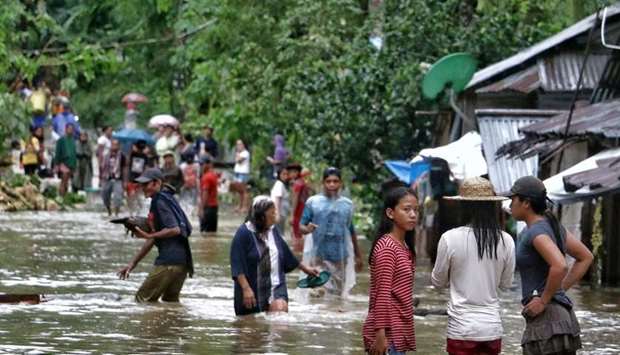Thousands of people heading home for Christmas in the Philippines were stranded on Sunday by Tropical Depression Kai-Tak, a day after the storm killed three people as it pounded the nation's eastern islands.
The storm has weakened, with gusts of up to 90 kilometres (56 miles) an hour, after cutting off power and triggering landslides in a region devastated by Super Typhoon Haiyan four years ago, state weather forecasters said.
Disaster officials on Sunday warned that more floods and landslides were possible and said 15,500 passengers were stranded because ferry services remained suspended in parts of the central Philippines.
‘I've been stranded for three days, sleeping in the bus, and I just want to get home to my family for Christmas,’ Eliaquin Pilapil, a 55-year-old farmer, told AFP from a port in the town of Matnog in the eastern province of Sorsogon.
‘We're given food once or twice a day and some of the passengers here are running out of money.’
The Christmas holidays are a busy travel season in the mainly Catholic Philippines, with people heading home to the provinces.
The archipelago nation is battered by about 20 major storms each year.
Kai-Tak, initially classified as a tropical storm, killed three people, injured 19 and forced 87,700 people from their homes when it tore across the eastern islands of Samar and Leyte on Saturday.
The two islands bore the brunt in 2013 of Super Typhoon Haiyan, which left more than 7,350 people dead or missing.
Kai-Tak toppled power lines in 39 towns or cities and damaged roads and bridges, the national disaster agency said.
In the Leyte city of Tacloban, it brought flash floods of up to 1.5 metres (five feet) and strong winds that left the city without power and water, according to its disaster office chief.
‘The storm moved so slowly that it brought so much rain to our city. The floods resulted from four days of rain,’ Ildebrando Bernadas, head of Tacloban's disaster risk reduction office, told AFP.
Bernadas said 82 percent of Tacloban's districts were flooded.
The storm also damaged farms and crops, bringing more misery to people who had been recovering from Haiyan's destruction.
‘We had a phobia from (Haiyan) which destroyed our coconut trees. We planted lettuce and eggplant but the new storm took them away too. It's devastating,’ Remedios Serato, a 78-year-old farmer in Leyte, told AFP.



